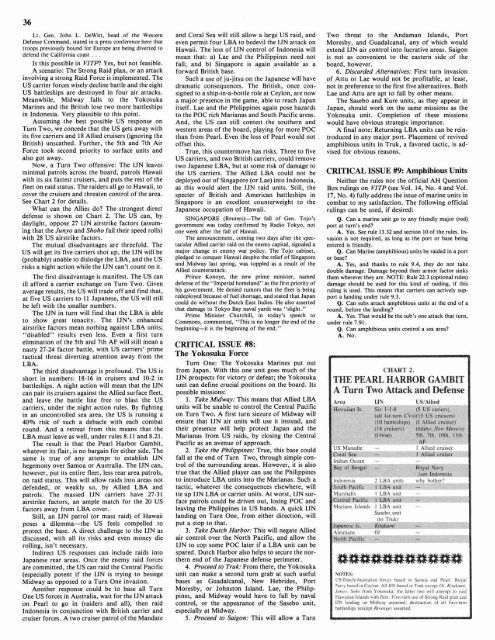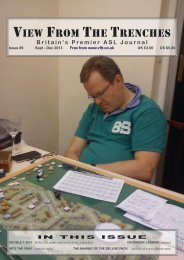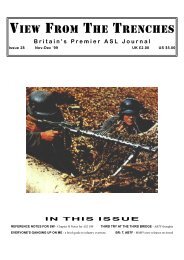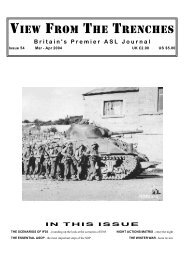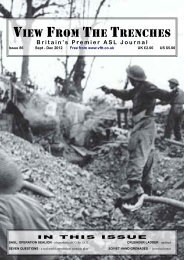18.64MB - View From The Trenches
18.64MB - View From The Trenches
18.64MB - View From The Trenches
- TAGS
- trenches
- www.vftt.co.uk
Create successful ePaper yourself
Turn your PDF publications into a flip-book with our unique Google optimized e-Paper software.
Lt. Gen. John L. DeWitt, head of the Western<br />
Defense Command, stated in a press conference here that<br />
troops previously bound for Europe are being diverted to<br />
defend the California coast . . .<br />
Is this possible in VZTP? Yes, but not feasible.<br />
A scenario: <strong>The</strong> Strong Raid plan, or an attack<br />
involving a strong Raid Force is implemented. <strong>The</strong><br />
US carrier forces wisely decline battle and the eight<br />
US battleships are destroyed in four air attacks.<br />
Meanwhile, Midway falls to the Yokosuka<br />
Marines and the British lose two more battleships<br />
in Indonesia. Very plausible to this point.<br />
Assuming the best possible US response on<br />
Turn Two, we concede that the US gets away with<br />
its five carriers and 18 Allied cruisers (ignoring the<br />
British) unscathed. Further, the 5th and 7th Air<br />
Force took second priority to surface units and<br />
also got away.<br />
Now, a Turn Two offensive: <strong>The</strong> IJN leaves<br />
minimal patrols across the board, patrols Hawaii<br />
with its six fastest cruisers, and puts the rest of the<br />
fleet on raid status. <strong>The</strong> raiders all go to Hawaii, to<br />
cover the cruisers and threaten control of the area.<br />
See Chart 2 for details.<br />
What can the Allies do? <strong>The</strong> strongest direct<br />
defense is shown on Chart 2. <strong>The</strong> US can, by<br />
daylight, oppose 27 IJN airstrike factors (assum-<br />
ing that the Junyo and Shoho fail their speed rolls)<br />
with 28 US airstrike factors.<br />
<strong>The</strong> mutual disadvantages are threefold. <strong>The</strong><br />
US will get its five carriers shot up, the IJN will be<br />
(probably) unable to dislodge the LBA, and the US<br />
risks a night action while the IJN can't count on it.<br />
<strong>The</strong> first disadvantage is manifest. <strong>The</strong> US can<br />
ill afford a carrier exchange on Turn Two. Given<br />
average results, the US will trade off and find that,<br />
at five US carriers to 11 Japanese, the US will still<br />
be left with the smaller numbers.<br />
<strong>The</strong> IJN in turn will find that the LBA is able<br />
to show great tenacity. <strong>The</strong> IJN's enhanced<br />
airstrike factors mean nothing against LBA units;<br />
"disabled" results even less. Even a first turn<br />
elimination of the 5th and 7th AF will still mean a<br />
nasty 27-24 factor battle, with US carriers' prime<br />
tactical threat diverting attention away from the<br />
LBA.<br />
<strong>The</strong> third disadvantage is profound. <strong>The</strong> US is<br />
short in numbers: 18-16 in cruisers and 10-2 in<br />
battleships. A night action will mean that the IJN<br />
can pair its cruisers against the Allied surface fleet,<br />
and leave the battle line free to blast the US<br />
carriers, under the night action rules. By fighting<br />
in an uncontrolled sea area, the US is running a<br />
40% risk of such a debacle with each combat<br />
round. And a retreat from this means that the<br />
LBA must leave as well, under rules 8.11 and 8.21.<br />
<strong>The</strong> result is that the Pearl Harbor Gambit,<br />
whatever its flair, is no bargain for either side. <strong>The</strong><br />
same is true of any attempt to establish IJN<br />
hegemony over Samoa or Australia. <strong>The</strong> IJN can,<br />
however, put its entire fleet, less rear area patrols,<br />
on raid status. This will allow raids into areas not<br />
defended, or weakly so, by Allied LBA and<br />
patrols. <strong>The</strong> massed IJN carriers have 27-31<br />
airstrike factors, an ample match for the 20 US<br />
factors away from LBA cover.<br />
Still, an IJN patrol (or mass raid) of Hawaii<br />
poses a dilemma-the US feels compelled to<br />
protect the base. A direct challenge to the IJN as<br />
discussed, with all its risks and even money die<br />
rolling, isn't necessary.<br />
Indirect US responses can include raids into<br />
Japanese rear areas. Once the enemy raid forces<br />
are committed, the US can raid the Central Pacific<br />
(especially potent if the IJN is trying to besiege<br />
Midway as opposed to a Turn One invasion.<br />
Another response could be to base all Turn<br />
One US forces in Australia, wait for the IJN attack<br />
on Pearl to go in (raiders and all), then raid<br />
Indonesia in conjunction with British carrier and<br />
cruiser forces. A two cruiser patrol of the Mandate<br />
and Coral Sea will still allow a large US raid, and<br />
even permit four LBA to bedevil the IJN attack on<br />
Hawaii. <strong>The</strong> loss of IJN control of Indonesia will<br />
mean that: a) Lae and the Philippines need not<br />
fall; and b) Singapore is again available as a<br />
forward British base.<br />
Such a use of ju-jitsu on the Japanese will have<br />
dramatic consequences. <strong>The</strong> British, once con-<br />
signed to a ship-in-a-bottle role at Ceylon, are now<br />
a major presence in the game, able to reach Japan<br />
itself. Lae and the Philippines again pose hazards<br />
to the POC rich Marianas and South Pacific areas.<br />
And, the US can still contest the southern and<br />
western areas of the board, playing for more POC<br />
than from Pearl. Even the loss of Pearl would not<br />
offset this.<br />
True, this countermove has risks. Three to five<br />
US carriers, and two British carriers, could remove<br />
two Japanese LBA, but at some risk of damage to<br />
the US carriers. <strong>The</strong> Allied LBA could not be<br />
deployed out of Singapore (or Lae) into Indonesia,<br />
as this would alert the IJN raid units. Still, the<br />
specter of British and American battleships in<br />
Singapore is an excellent counterweight to the<br />
Japanese occupation of Hawaii.<br />
SINGAPORE (Reuters)-<strong>The</strong> fall of Gen. Tojo's<br />
government was today confirmed by Radio Tokyo, not<br />
one week after the fall of Hawaii.<br />
<strong>The</strong> announcement, coming two days after the spec-<br />
tacular Allied carrier raid on the enemy capital, signaled a<br />
major change in enemy war policy. <strong>The</strong> Tojo cabinet,<br />
pledged to conquer Hawaii despite the relief of Singapore<br />
and Midway last spring, was toppled as a result of the<br />
Allied counterattack.<br />
Prince Konoye, the new prime minister, named<br />
defense of the "Imperial homeland" as the first priority of<br />
his government. He denied rumors that the fleet is being<br />
redeployed because of fuel shortage, and stated that Japan<br />
could do without the Dutch East Indies. He also asserted<br />
that damage to Tokyo Bay naval yards was "slight."<br />
Prime Minister Churchill, in today's speech to<br />
Commons, commented, "This is no longer the end of the<br />
beginning-it is the beginning of the end."<br />
CRITICAL ISSUE #8:<br />
<strong>The</strong> Yokosuka Force<br />
Turn One: <strong>The</strong> Yokosuka Marines put out<br />
from Japan. With this one unit goes much of the<br />
IJN prospects for victory or defeat; the Yokosuka<br />
unit can define crucial positions on the board. Its<br />
possible missions:<br />
1. Take Midway: This means that Allied LBA<br />
units will be unable to control the Central Pacific<br />
on Turn Two. A first turn siezure of Midway will<br />
ensure that IJN air units will use it instead, and<br />
their presence will help protect Japan and the<br />
Marianas from US raids, by closing the Central<br />
Pacific as an avenue of approach.<br />
2. Take the Philippines: True, this base could<br />
fall at the end of Turn Two, through simple con-<br />
trol of the surrounding areas. However, it is also<br />
true that the Allied player can use the Philippines<br />
to introduce LBA units into the Marianas. Such a<br />
tactic, whatever the consequences elsewhere, will<br />
tie up IJN LBA or carrier units. At worst, IJN sur-<br />
face patrols could be driven out, losing POC and<br />
leaving the Philippines in US hands. A quick IJN<br />
landing on Turn One, from either direction, will<br />
put a stop to that.<br />
3. Take Dutch Harbor: This will negate Allied<br />
air control over the North Pacific, and allow the<br />
IJN to cop some POC later if a LBA unit can be<br />
spared. Dutch Harbor also helps to secure the nor-<br />
thern end of the Japanese defense perimeter.<br />
4. Proceed to Truk: <strong>From</strong> there, the Yokosuka<br />
unit can make a second turn grab at such useful<br />
bases as Guadalcanal, New Hebrides, Port<br />
Moresby, or Johnston Island. Lae, the Philip-<br />
pines, and Midway would have to fall by naval<br />
control, or the appearance of the Sasebo unit,<br />
especially at Midway.<br />
5. Proceed to Saigon: This will allow a Turn<br />
Two threat to the Andaman Islands, Port<br />
Moresby, and Guadalcanal, any of which would<br />
extend IJN air control into lucrative areas. Saigon<br />
is not as convenient to the eastern side of the<br />
board, however.<br />
6. Discarded Alternatives: First turn invasion<br />
of Attu or Lae would not be profitable, at least,<br />
not in preference to the first five alternatives. Both<br />
Lae and Attu are apt to fall by other means.<br />
<strong>The</strong> Sasebo and Kure units, as they appear in<br />
Japan, should work on the same missions as the<br />
Yokosuka unit. Completion of these missions<br />
would have obvious strategic importance.<br />
A final note: Returning LBA units can be rein-<br />
troduced in any major port. Placement of revived<br />
amphibious units in Truk, a favored tactic, is ad-<br />
vised for obvious reasons.<br />
CRITICAL ISSUE #9: Amphibious Units<br />
Neither the rules nor the official AH Question<br />
Box rulings on VZTP (see Vol. 14, No. 4 and Vol.<br />
17, No. 4) fully address the issue of marine units in<br />
combat to my satisfaction. <strong>The</strong> following official<br />
rulings can be used, if desired:<br />
Q. Can a marine unit go to any friendly major (red)<br />
port at turn's end?<br />
A. Yes. See rule 13.32 and section 10 of the rules. In-<br />
vasion is not required, as long as the port or base being<br />
entered is friendly.<br />
Q. Can Marine (amphibious) units be raided in a port<br />
or base?<br />
A. Yes, and thanks to rule 9.4, they do not take<br />
double damage. Damage beyond their armor factor sinks<br />
them wherever they are. NOTE: Rule 22.3 (optional rules)<br />
damage should be used for this kind of raiding, if this<br />
ruling is used. This means that carriers can actively sup-<br />
port a landing under rule 9.3.<br />
Q. Can subs attack amphibious units at the end of a<br />
round, before the landing?<br />
A. Yes. That would be the sub's one attack that turn,<br />
under rule 7.91.<br />
Q. Can amphibious units control a sea area?<br />
A. No.<br />
CHART 2.<br />
THE PEARL HARBOR GAMBIT<br />
A Turn Two Attack and Defense<br />
Sasebo unit<br />
USIDutchlAustralian forces based in Samoa and Pearl. Royal<br />
Navy based In Ceylon. All IJN baaed in Truk except 01. Klrakarni,


